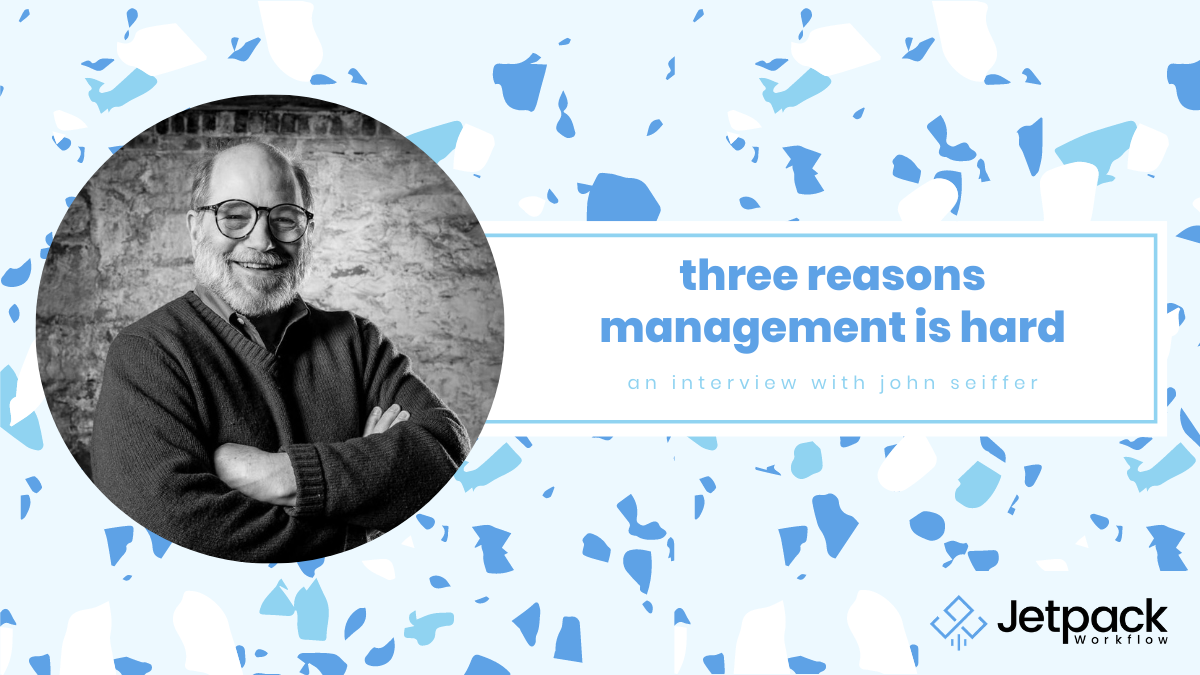Three Reasons Management is Hard

John Seiffer has been an entrepreneur all his working life. In 1994 he started working with other entrepreneurs helping them learn from his mistakes. He was part of the team that founded the International Coach Federation and was its third president in 1998. He is a past president of the Angel Investor Forum. John has worked with company owners and CEOs across the USA and in Europe through his platform, CEOBootCamp.com. John can be reached at john@ceobootcamp.com.
Today, John will discuss the three reasons why management is hard and tips and solutions to make it a little more simple.
Podcast
Summary
- “Management is getting work done through other people.”
- Reason #1: It’s not your full-time job.
- Reason #2: You’re afraid of micromanaging.
- Reason #3: Management is not social intercourse.
John’s Management Background
As an entrepreneur turned business owner coach, John has been in a variety of positions that required success from a management standpoint. He has learned exactly what it takes to run a team that produces impressive results. In his words, “management is getting work done through other people.” By translating this truth into approach and his willingness to help others reach their professional goals, he is left with the ideal background to help you better manage your team. John is aware that management is hard, but he also knows plenty of ways to make it a little more simple.
Reason #1: It’s not your full-time job.
Managing people can be difficult because it is not the only thing you do. In many companies, a manager is expected to manage people and complete their own workload. This can cause resentment towards your responsibility to manage because you feel like it takes you away from your other tasks. However, you and your team will be far more productive when you designate a set time to complete your management work.
John’s simple solution: time blocking. Time blocking allows you to complete your tasks and set aside time to work with your team (even if it is just a few hours a week). He suggests making it a routine by scheduling regular team meetings and time to meet individually with each member.
One-on-one meetings allow you to get a sense of a person’s career goals and give you a better idea of how you can support them through their professional development. One tip John offers is to let the employee come to you with an agenda for each one-on-one meeting. This will allow you to see where they feel they are professionally and create a more trust-filled relationship. When you do ask questions, make it clear you are searching for answers that will help you better support them.
For sample questions, read John’s recent blog, 1:1 Meetings Lead to Loyal Employees.
Reason #2: You resist micromanaging.
Oftentimes managers avoid giving detailed, defined tasks because they are afraid to come across as a micromanager. However, as a manager, it is your responsibility to break down work into specific tasks and allow employees to use their creativity from there. Knowledge workers may be good at their jobs, but that doesn’t mean they don’t require support to complete their tasks.
One of the ways John suggests doing this, without sounding like a micromanager, is by making sure everything relates back to giving the customer the best service. It is important your employees know why the detailed instructions you’ve created have a positive influence on the quality of work the team produces as a whole.
Another bit of advice he offers is to define a communication protocol. Setting a standard way to relay information “gives people the freedom to know how they’re going to communicate and when they are going to get a response.” These internal communication rules should be similar to external/client communications rules in that there is a particular way that information should be passed along in order to receive a timely and accurate response.
Designating specific responsibilities and setting a communication structure enables people to do better work, which ultimately is the goal of management.
Reason #3: Management is not social intercourse.
Being in management is an unnatural act. The way we are required to communicate with our team members is unlike the way we communicate in our other relationships. For example, giving constant praise when you see good stuff happening in the workplace is essential, however doing this outside of a work setting is not natural.
Taking the social route in workplace relationships can also lead to behavior that wouldn’t normally be tolerated. John explains it this way: “You wouldn’t put up with things in a good manager relationship that you might in a good social relationship.”
John introduces the idea of radical candor. This is mixing showing you care with the willingness to challenge your team members with things that might make them uncomfortable. Again, this helps create a good balance between a professional relationship and a social relationship. However, he stresses that radical candor is a two-way street. Your team should trust that you trust them and are open to receiving radical candor in return. Their feedback is essential to helping you create a productive, well-run team.
To encourage a kinder, yet productive work environment, John suggests getting your team to agree on language that gets your point across but won’t be taken personally. Something like “can you laser that for me” instead of, “can you get to the point” comes off much nicer. But the phrase itself doesn’t matter – what works is the agreement about how the team will use it.
Ultimately, John makes it clear that being intentional and willing to improve your management style based on the feedback from your team are essential qualities. He explains that it is your job to “improve them so they can improve you.”
Management is hard but it is not impossible to simplify.
To learn more tips from John, listen to or watch the full episode above!





